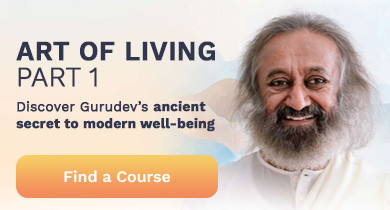By Shalini Parekh | Posted: December 17, 2018
Harness the secrets of this ancient science to stop counting the calories and begin counting your blessings.
20 years ago, yoga may have been that fringe esoteric practice that was for hippies and spiritual seekers; not the billion dollar industry it has become today. Here’s a secret: the same will be true for Ayurveda 10 years from now, and maybe even sooner!
I recently had a pulse diagnosis with an Ayurvedic doctor called a Vaidya. What is a Vaidya? Like the stethoscope helps the doctor hear your lung or heart function, the pulse gives us unique information about diseases, imbalances, and the prakriti, or nature, of the individual. It is the way our nadi, or the subtle energy channels in our body, reveal signals that determine our intrinsic nature, or doshas, and diagnose diseases. A Vaidya is the one who is expert in reading our nadi and provide us accurate information about our constitution and advise us lifestyle changes based on the reading.
My gregarious friend, who can eat her heart out, may fare better than my perfectionist friend who counts every calorie, on a diet of the same food. Nutrition, as we understand it in western science, is a one-size-fits-all frame. In Ayurveda, on the other hand, it is unique to every individual. We are not a sea of sameness. My quick-to-lose-her-temper friend, for example, will certainly be spewing fire if she eats the spicy food that she may like. The same food that may be good for some of us may not always be good for all body types, universally.
And herein emerges the contradiction in that much-bandied word - nutrition. If I served you that same heap of almonds that I served the next person, it will not serve up the same benefits that we suppose it will. You, being of a warm temperament, will benefit from the cooling properties of almonds. The cool-tempered person may need to eat less, though, as almonds may sit in the belly undigested in larger quantities. Oh, now we are warming up! How do I know this? Well, in reality, you know it too. We all intuitively know what feels good to us and what our body craves -- well, as long as when it is in the balance!
T’is the season for warm spiced cider, eggnog, and pumpkin pies with cinnamon and nutmeg. We gravitate towards our bodies’ deepest instincts. The season and our body’s signals are that barometers with which we measure our likes and dislikes. Ice cream in freezing weather is not something you will crave, and a steaming cup of hot chocolate is hard to say no to in cold weather.
The intelligence of the body is well-guided these days by the ever-present information that technology provides at our fingertips. What technology will not provide for sure, is, the intuitive wisdom that helps us lean into these choices. Ayurveda helps decode the archetypes of our bodies, thereby helping us understand the imbalances of it, and even provides the ability to predict what problems we might be able to avoid or are helping bring on.
In counting calories, not only are we short-changing ourselves somewhere, but we are not able to appreciate the fullness and abundance of the harvest of nature that we are meant to enjoy. Add a dollop of butter to your soup, and enjoy in moderation all the foods on your table. Take in the flavors and the fragrances. When we are in balance, Ayurveda is the essence of who we are. Here are a few simple Ayurveda-inspired ideas you can count on to make your this holiday season less stressful and more magical.
1. Meditate
We almost always bring all of our life’s emotional issues to the dining table or the couch, wherever it is that we eat. Every choice is a culmination of our environment, our conditioning, our patterns of thinking, and our behaviors. When these patterns are so predetermined, how then can we shake off a food habit that is not life-supporting?
A few minutes of silence and meditation is not a luxury. It is a very real necessity. A friend, a busy consultant, who travels frequently and visits a particular restaurant whilst in a town, takes about 15 min to meditate before he orders. The owner of that restaurant recognized this regular patron and was accustomed to him meditating before he ate. One day my friend came in and ordered his food and then proceeded to start eating right away. When the concerned owner asked his patron why he omitted to meditate today, he received this answer with a smile, “Oh today I meditated for a few minutes in the car before I came in.”
Once one has experienced the effects of meditation, one can hardly pass up its benefits!
2. Drink hot water
If you have traveled in the East, you will be mindful before you order water with ice! In fact, during my travels to Hong Kong, I was pleasantly surprised that warm to room temperature water is naturally served everywhere. Compare that to downing ice cold water along with one’s meal! The effect that has on dousing the agni, or fire, which in Ayurveda is the foundation of your digestive health, is almost instant. Your digestive process gets a dampening surprise every time you pour cold water over it. Especially during the holidays, choose a hot cup of plain water or herbal tea after most meals to balance overeating, eating too much sugar or savory food, or even eating heavy or fried foods. This is my go-to after an indulgent meal!
3. Use plenty of warming spices
Ayurveda explains that cold weather increases the vata, or air element, in the body. Eating plenty of warming spices, like cloves, cinnamon, black pepper, nutmeg, cardamom, ginger, and turmeric helps balance the body during the winter holiday months. These spices help reduce the air element that alleviates seasonal mood disorders, joint pains, arthritis that gets aggravated by the cold, and even depression.
4. Practice Yoga and Ayurveda in conjunction
The confluence of Yoga and Ayurveda is magical. Ayurveda is the sister science to Yoga, perhaps even its mother. In reality, one almost cannot be practiced without the other. A sattvic diet - a diet that is fresh, comprising predominantly of seasonal fruits and vegetables - is recommended for asanas to have a beneficial effect. In fact, in advanced asana, practicing a non-sattvic-diet can even have a harmful effect.
During the holidays, soups, squashes, and pumpkin are choices that are high on the sattvic scale. Too much meat, processed foods, and sugars bring the prana, or energy level, of the body down. The confluence of Yoga and Ayurveda is significant in understanding one’s body type and how to plan an asana sequence that is nourishing rather than depleting for the body, especially during the busy holiday season. Once this awareness dawns, the intelligence of the body starts honing in on an ideal practice. The result? More energy to enjoy the things that are meaningful to you.
I try to give myself a warm olive oil massage called Abhayanga in Ayurveda, during the winter months, sometimes before I practice Yoga, to warm the muscles. This is also significantly calming for the nervous system, as well as toning for the muscles before yoga practice, and when one showers with warm water subsequently, the oil permeates the body, opening the subtle channels, or nadis, in the body.
5. Count on your intention and intuition rather than counting calories
The blessings and bounties of nature are manifold. Calories are simply not the way to add them up. That is the path to deprivation and denial of what can be an enjoyable and satisfying experience. Nourishing good fats like ghee, olive oil, and coconut oil send happy signals to the brain, and chances are that this, in turn, reduces our cravings. Eating with intention includes mindful eating in a pleasant and calm environment. If you are surrounded by too many holiday stressors, step back take a deep breath, perhaps a short walk in nature, and fresh air will revive you and help you balance your food choices without drowning in feelings of craving or guilt.
Avoid negative acts of complaining or comparing whilst eating, instead focus on praising, appreciating and offering your gratitude. From time immemorial, in all cultures, offering a prayer or saying your Grace, or any words of gratitude, is truly a magical act, an opportunity to bless and offer gratitude for the abundance we are bestowed with. It is a sublime intention of treating as sacred that which nourishes every cell in your bodies. Eating with joy and gratitude can hardly be overemphasized.
Surrounded by the holiday cheer, one is sometimes overwhelmed by conversation and company. Eating joyfully, yet with deep gratitude, is the secret to enjoying the abundance on your dining table. A full belly is the sign of happiness, whether depicted by the statues of laughing Buddha or the idols of the big-bellied, happy Ganesha, or even in the rolling laughter of Santa! Make your hearty meal a consciously happy one.
Ancient Ayurvedic texts are filled with hymns that are recited to honor our food. Remember that food is not a commodity to be counted in calorific numbers, nor one that can be simply bought and served, but a divine and magical opportunity for us to reconnect with ourselves — an offering, served up with love, accompanied by the magic of Grace!
Shalini Parekh has taught yoga in the Chicago area for almost 20 years. She believes that you teach best what you need to learn the most and is passionate about bringing the nuances of ancient yoga philosophy to the forefront of modern yoga practice. She is also a journalist and writes about issues of identity, culture, and politics.





























